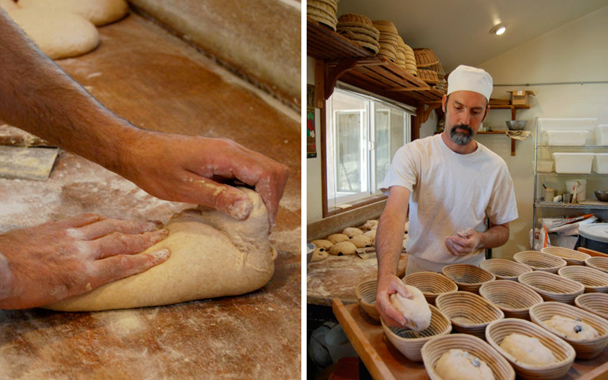Last January, when stocking up on almonds and walnuts at the Chico (California) farmers market, I was stopped by some of the most appealing breads I had seen in a long time. They weren’t fancy, but they just looked as if you could eat them and come away completely nourished and thoroughly fed. They had been baked by an aptly named young man, Dave Miller, who not only uses a wood-fired oven, but also mills his own grains, which is unusual. Even more unusually, the grains he uses are grown nearby on small farms in this northern end of the Central Valley. Wanting to learn more, I returned this summer to visit Dave and Miller’s Bake House.
I expected the bakery would be in Chico, but it was a 20-mile drive through rising grass-covered hills to a place called Yankee Hill. After dropping off the main road, I drove down a rough, twisting driveway to Miller’s small house, solar panels in view. Quiet-spoken and passionate about bread in a matter-of-fact sort of way, Dave told me he first discovered that a bakery “was the coolest place to be” in Edinburgh, where he had spent his junior year abroad because English was spoken there. After he returned to college and created a little business delivering birthday cakes that he bought from a store across the street, he tasted sourdough bread for the first time and woke up to the possibilities.
“My whole body felt something from it,” he recalled, and after apprenticing here and in Europe, he worked at an organic bakery in southern California before starting his own place.
“Would you like to see it?” he asked. He opened his living-room door and we walked right into a small, immaculate bakery. Rows of bannetons were waiting to be filled with dough, a fire of oak and almond was blazing in the wood oven, and dough was rising nearby. Everything exuded an aura of readiness for baking early the next morning. First, though, the temperature in the oven would rise to considerable heights then fall to about 600°F, a process that takes up to 20 hours, which may be one reason why Dave bakes only two days a week.
Despite his commitment to the oven and the beauty of baking bread in its radiant heat, Dave admitted that there were limitations. He doesn’t use a steam system, for instance, because steam can destroy the oven, which means rebuilding it; and he sometime gets irregular breads. “I’ve had to train my customers to accept what I do and what the oven does,” he explained, and train his customers he has, for Dave has a loyal following. He could get bigger, but he doesn’t want to grow.
“I sell at the farmers market and a couple of local natural foods stores,” he said. And that’s enough.
Along with the wood-fired oven and his adherence to slow, natural fermentation, it’s the milling of his grains that sets Dave and his bread apart. In a separate room, just large enough to hold it, stands an enormous wooden mill from Austria that holds the stones that grind the grain into flour. It feels as if this is the heart of the bakery, for Dave’s belief in the importance of direct milling to the life force of the bread is paramount. He talked about the regenerative power of grain, how it is able to wait and wait to produce new life. It needs only to be broken and to come into contact with warmth and moisture to spring into a living entity. “The moment the grain is milled is the moment of its greatest life-giving potential,” Dave said, “and the dough is made while the flour is fresh and alive.”
Dave estimates the miles his wheat and other grains travels to market via his bread is about 250—a remarkably low number for any product, but especially for bread that usually relies on grain grown much farther away, in Canada and the Dakotas. He buys his grain directly from the farmer and pays three times the price a farmer usually receives for organic grain—an admirable example of fair trade at home, and one that might encourage young people to farm. The present system keeps the farmers’ price so low that virtually no one wants to take on what amounts to a guarantee of hard work and poverty. And certainly we need more farmers, including those who grow grain.
Dave produces 12 different breads from five doughs. (He also makes barley-flour cookies, a seasonal pepper cornbread, and whole-grain pasta that people tell me is silky and elegant.) He and his wife sent me home with a bag of sliced breads: spelt, sesame, and kamut. My husband and I ate off of them for more than a week, and even at the end, the last piece tasted utterly alive. I still have the taste and feel of that bread in my memory. It’s one of the most deeply nourishing foods I’ve encountered, which is different than delicious, although the two can be joined, as they were here.
I think about how bread is something we take for granted, and also how it’s something we’ve learned to shun—all those carbohydrates and calories. But few breads we come across communicate the deep nourishment of food that is alive, the way Dave’s bread is. It is not just filler, or something to put things on, but real food, bread with real heart and soul.




 Pinterest
Pinterest


